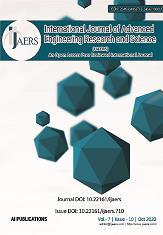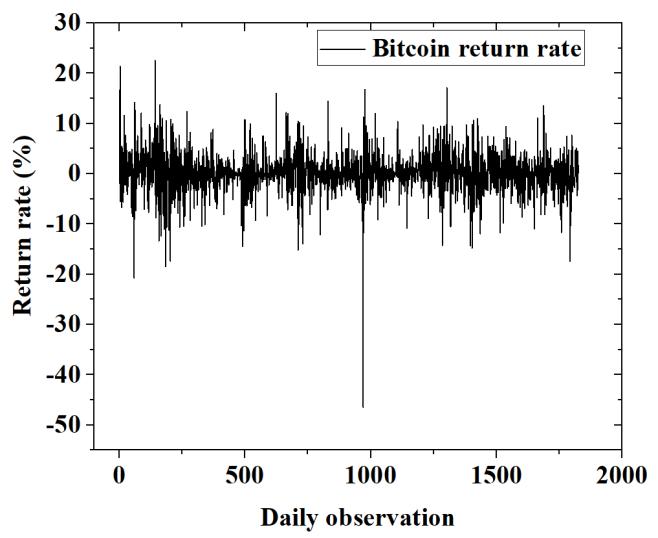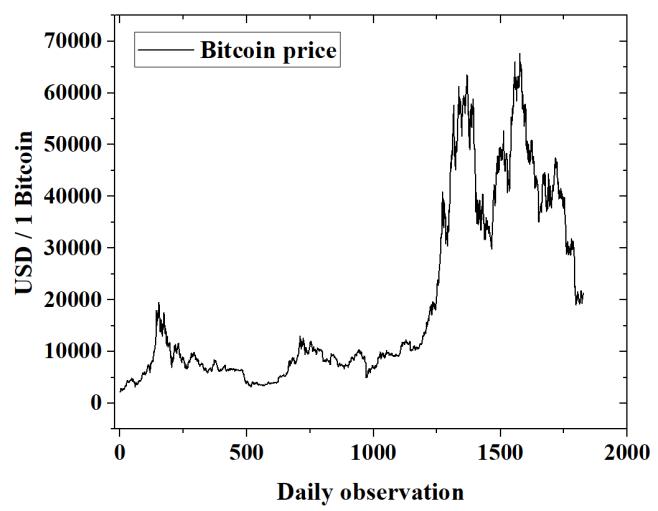Modeling Volatility for High-Frequency Data of Cryptocurrency Bitcoin Price using Generalized Autoregressive Conditional Heteroskedasticity (GARCH)
Model
Nashirah Abu Bakar1, Sofian Rosbi2
1Islamic Business School, College of Business, Universiti Utara Malaysia, 06010 Sintok,Kedah,Malaysia
2Faculty of Business & Communication, UniversitiMalaysia Perlis,01000 Kangar, Perlis,Malaysia
Received: 28 Aug 2022,
Received in revised form: 20 Sep 2022,
Accepted: 24 Sep 2022, Available online: 30 Sep 2022 ©2022 The Author(s). Published by AI Publication. This is an open access article under the CC BY license (https://creativecommons.org/licenses/by/4.0/).


Keywords Cryptocurrency, Bitcoin, Volatility,GARCHModel,HighFrequency Data.
Abstract The cryptocurrency namely Bitcoin is a decentralized cryptocurrency considered a type of digital asset that uses public key cryptography to record, sign and send transactions over the Bitcoin blockchain. All transaction processes are performed without the oversight of a central authority. The time series data for Bitcoin price movement exhibit time varying volatility and volatility clustering This study aims to evaluate the time varying volatility of Bitcoin price using the Generalized Autoregressive Conditional Heteroskedasticity (GARCH) model. This study uses daily share prices starting from July 2017 until July 2022. The mean equation was developed using the ARMA (1,1) for Bitcoin return. Next, this study evaluated OLS, GARCH, GARCH M, and E GARCH models. The result shows the EGARCH (1,1) model exhibits its lowest error of AIC with a value of 5.5984. The autocorrelation test was performed using Q statistics indicating EGARCH (1,1) model is free from the autocorrelation problem. In addition, ARCH LM test indicates EGARCH (1,1) is free from heteroscedasticity problems. The EGARCH (1,1) shows there is a leverage effect for volatility clustering. This explained the behavior of bad news effect more than positive news. The finding of the study can act as a guideline to help investors to analyze their investment behavior. At the same time, the finding of this study helps investors to understand the cryptocurrency dynamics behavior.
I. INTRODUCTION
The increasing demand for Bitcoin cryptocurrency investment was attract more research to investigate the expected return and volatility of Bitcoin investment. This is due to the high demand from investors to invest in Bitcoin portfolios. As reported by coinmarketcap.com (2022), the market capitalization for Bitcoin cryptocurrency exceeds more than USD$372 billion, which is higher than other cryptocurrencies such as
Ethereum cryptocurrency, which is USD$167 billion, and Tether cryptocurrency, which is USD$67 billion.
This pattern shows the aggressive demand for Bitcoin cryptocurrency investment. Bitcoin cryptocurrency is used as an investment class asset to earn profits. Bitcoin also considers a commodity because it can be traded in the spot as well as in the futures market like any other physical commodity (Dubey, 2022).
According to Lee and Rhee (2022), the price of Bitcoin cryptocurrency was rise since the mining process of Bitcoin cryptocurrency started in the early year of 2009. Since the year 2022, the demand for Bitcoin cryptocurrency was increased and attracted more investors to participate in Bitcoin cryptocurrency investments (Abu Bakar, et al., 2020). Cryptocurrencies are recognized by investors as an alternative asset or diversification option for reducing the exposed risk of their portfolios (Hung, 2022).
However, many researchers found that investments in Bitcoin cryptocurrency face high volatility and risk (Abu Bakar, et al., 2019a). According to Diniz, et al., (2022), the year of 2017 marks a new period of high volatility and appreciation in the cryptocurrency markets. The market price of Bitcoin rose more than 1,700% in the year 2017, bringing further discussions of the existence of a bubble.
Therefore, this study performs to investigate the time varying volatility of Bitcoin price using the Generalized Autoregressive Conditional Heteroskedasticity (GARCH) model. Abu Bakar, et al., (2019b) develop forecasting cryptocurrency price movement using the moving average indicating that the comparison among prediction methods shows the 2 day moving average method is the best prediction method with the lowest mean absolute error percentage for all observation periods of Bitcoin cryptocurrency price. Thus, this study used the GARCH model to evaluate the time varying volatility of Bitcoin prices from July 2017 until July 2022.
II. LITERATURE REVIEW
Bitcoin exceeded a market capitalization of US$372 billion in September 2022, thereby attracting the interest among investors and corporations to invest in the cryptocurrency market. However, Bitcoin cryptocurrency is involved in high volatility indicating this investment is considered a high risk investment (Benlagha and Hemrit, 2022; Grira, et al., 2022).
Many types of research are conducted to investigate the volatility of Bitcoin cryptocurrency investment. Cryptocurrency defines as a digital currency in which encryption techniques are used to regulate the generation of units of currency and verify the transfer of funds, operating independently of a central bank
The study by Abu Bakar, et al., (2017) mentioned that Bitcoin is a type of cryptocurrency. Balances are kept using public and private keys which are long strings of numbers and letters linked through the mathematical encryption algorithm that was used to create. The public key (comparable to a bank account number) serves as the
address published to the world and to which others may send Bitcoins.
Besides that, Dubey, (2022) found that oil price, bitcoin supply, trading volume, and market capitalization significantly influence the price of bitcoin in the long run. While in the short run investors, market capitalization, S&P 500 returns, and trading volume significantly affect the Bitcoin returns.
The other study that compares Bitcoin with other investments also suggests that Bitcoin cryptocurrency are risk investment. Therefore, a study by Kamran, et al., (2022) show Bitcoin offered a weak safe haven and hedging benefits when combined in a portfolio with S&P/ASX 200 Financials index, S&P/ASX 200 Banks index, or S&P/ASX 300 Banks index. Concerning the S&P/ASX All Ordinaries Gold index, Bitcoin is a risky investment with inconsistent safe haven and hedging benefits.
Currently, investors have the option to invest in various investment platforms such as the stock market, gold market, crude oil market, and other platforms. Various investment platform including the cryptocurrency market shows the dynamic behavior of price and risk give an impact on the return of investment. In addition, investors and companies have opportunities to select the best portfolio investments. As the main objective of investors is to generate a good return, thus, they need to choose a good investment portfolio that can generate a good return and low risk.
Therefore, much research conducted to investigate the performance of the stock market, gold market, cryptocurrency market, and other markets. A study by Kumar, et al., (2022) indicate that positive changes in Bitcoin do not the affected stock market in the long term (Kumar, et al., 2022). Thus, they concluded that each investment has its own dynamic behavior in generating a good return and managing the risk of investment.
Nowadays, the spread of the Covid 19 virus gives an impact on all investment portfolios worldwide. The infection of Covid 19 is not only considered become a public health crisis but also affected the global economy at a critical level. A significant economic impact has already occurred across the globe due to reduced productivity, loss of life, business closures, trade disruption, and decimation of the tourism industry (Abu Bakar and Rosbi, 2022; Abu Bakar, et al., 2022; Abu Bakar and Rosbi, 2021a; Abu Bakar and Rosbi, 2021b; Abu Bakar and Rosbi, 2020a).
Hence, a study by Kakinuma, (2022) regarding empirical evidence on the return and volatility spillover effects between Southeast Asian stock markets, Bitcoin, and gold in the periods before and during the Covid 19
pandemic shows the stocks in Southeast Asia, Bitcoin and gold become interdependent during the pandemic. While during turbulent times, the contagion effect is inevitable regardless of region and asset class.
In addition, a study by Abu Bakar and Rosbi, (2020b) regarding the impact of Covid 19 on the equity market and currency exchange indicates a negative value. Therefore, Covid 19 happened in the year 2019 and contributed to a huge impact on the economy worldwide.
III. RESEARCH METHODOLOGY
This study uses generalized autoregressive conditional heteroscedasticity (GARCH) to evaluate time varying volatility. Therefore, this study started with evaluating data normality distribution using Jarque Bera test. Then, the analysis continues to the unit root test namely ADF, PP, and KPSS. Next, this study performed modeling selection where the ARMA model is selected. Then, this study performed autocorrelation problem checking and heteroscedasticity problem checking. After that, GARCH models were implemented to model the data.
3.1 Normality testing using Jarque Bera test.
An assessment of the normality of data is a prerequisite for many statistical tests because normal data is an underlying assumption in parametric testing. The normal distribution is a continuous probability distribution that is symmetrical around its mean, most of the observations cluster around the central peak. Normal distribution, also known as the Gaussian distribution, is a probability distribution that is symmetric about the mean, showing that data near the mean are more frequent in occurrence than data far from the mean.
In statistics, the Jarque Bera (JB) test is a goodness of fit test of whether sample data have the skewness and kurtosis matching a normal distribution. The test statistic is always non negative. If it is far from zero, it signals the data do not have a normal distribution The JB statistic test is represented using Equation (1).
3.2 Unit root test using ADF, PP, and KPSS
In statistics, a unit root test tests whether a time series variable is non stationary and possesses a unit root. An Augmented Dickey Fuller test (ADF) tests the null hypothesis that a unit root is present in a time series sample. The augmented Dickey Fuller (ADF) statistic, used in the test, is a negative number. The more negative it is, the stronger the rejection of the hypothesis that there is a unit root at some level of confidence. The ADF test is
Hypothesis:
H , series has unit root characteristics.
H , series is a stationary data set
Next, the second test for unit root is Philips and Perron (PP). The PP test proposes an alternative to the unit root test as a nonparametric method of controlling for serial correlation. The null hypothesis for the PP test shows series has a unit root. Meanwhile, the alternative hypothesis shows series is stationary.
Then, the third unit root test is The Kwiatkowski Phillips Schmidt Shin (KPSS). The KPSS test figures out if a time series is stationary around a mean or linear trend or is non stationary due to a unit root. A stationary time series is one where statistical property are considered the mean and variance values are constant over time. The null hypothesis for the test is that the data is stationary. The alternate hypothesis for the test is that the data is not stationary.
Autoregressive Moving Average (ARMA) model.
ARMA is a model of forecasting in which the methods of autoregression (AR) analysis and moving average (MA) are both applied to time series data that is well behaved. In ARMA it is assumed that the time series is stationary and when it fluctuates, it does so uniformly around a particular time.
ARMA process is represented by using Equation (3). This equation was developed for ARMA (1,1) model.
Equation
variable
mean value
Next, Figure 2 shows the value of the return rate for Bitcoin. The dynamic behavior of the Bitcoin return rate shows the volatility characteristics with clustering. Therefore, the ARCH effect exists in data.

Generalized Autoregressive Conditional Heteroscedasticity (GARCH) model.
4 RESULT AND DISCUSSION
This section describes four components: data selection procedure, unit root testing, ARMA model specification, and GARCH analysis.
4.1 Data selection procedure
This study uses daily Bitcoin prices starting from 17th July 2017 until 17th July 2022. There are 1827 daily observations involved in this analysis. Figure 1 shows the movement of Bitcoin prices over 5 years. The value for Bitcoin on the 1st observation is USD 2229.4 for one unit. The maximum value of Bitcoin is USD 67566.8 on the 7th November 2021 (1576th observation). The last observation exhibits Bitcoin price is USD 21228.2.

Fig. 2: Volatility rate for Bitcoin return
Table 1 shows descriptive statistics for the Bitcoin return rate. The mean value for Bitcoin return is 0.123442 %. The maximum value for the Bitcoin returns rate is 22.51190 % at 144th daily observation. Meanwhile, the minimum value for Bitcoin return is 46.47302 % at 970th daily observation. As shown in Table 1, the value of the statistics for kurtosis indicates the data distribution follows the non normal distribution. It is supported by a numerical statistical test namely Jarque Bera statistical test which indicates the value is 9375.434 with a probability value is 0.0000. The probability value indicates the data distribution for the Bitcoin return rate is non normal distribution.
Next, this study performed unit root to check for stationarity of Bitcoin return data. Table 2 shows three types of unit root tests namely ADF, PP, and KPSS. The data for Bitcoin return follows stationary characteristics. The parameters such as mean and variance do not change over time.
Table.1: Descriptive statistics for Bitcoin return rate
Parameter Value
Mean 0.123442
Median 0.177448
Maximum 22.51190
Fig. 1: Bitcoin price for over 5 years
Minimum 46.47302
Std. Dev. 4.187009
Skewness 0.705640
Kurtosis 14.01064
Jarque Bera statistic 9375.434
Probability 0.000000
Distribution Non normal distribution
Table.2: Unit root tests for Bitcoin return
Variable: Level ADF PP KPSS
No intercept, No trend 44.30181 44.29933 Not applicable
Probability 0.0001 0.0001
Comment Stationary Stationary
With intercept, No trend 44.32883 44.32036 0.194
Probability 0.0001 0.0001 0.46300
Comment Stationary Stationary Stationary
With intercept, With trend 44.35202 44.33940 0.134175
Probability 0.0000 0.0000 0.14600
Comment Stationary Stationary Stationary
Table 3 shows estimation of the model for Bitcoin return rate and volatility. The four models involved are OLS, GARCH (1,1), GARCH (1,1) M and EGARCH (1,1). In this study, EGARCH (1,1) selected the most suitable model for analyzing volatility for Bitcoin return. The value for AIC is the lowest with a value of 5.5984 for EGARCH (1,1).
Table.3: Estimation of the models
Model OLS GARC H (1,1) GARCH (1,1) M EGARC H (1,1)
1. Mean Equation ARMA (1,1)
0.1232 0.1546 0.2307 0.1227
Probability 0.2066 0.4411 0.6322 0.2001
1 0.6774 0.8079 0.8203 0.7916
Probability 0.0009 0.0001 0.0000 0.0000
1 0.6383 0.8006 0.8106 0.7765
Probability 0.0025 0.0002 0.0000 0.0000
0.1053
Probability 0.4054
2. Model selection
Akaike info criterion (AIC)
Schwarz criterion (SC)
Hanna Quinn criteria (HQC)
5.7029 5.8351 5.6068 5.5984
5.7149 5.8532 5.6279 5.6196
5.7073 5.8417 5.6146 5.6062
Model OLS GARC H (1,1) GARCH (1,1) M EGARC H (1,1)
3. Variance Equation
11.3769 1.0290 0.0892
Probability 0.0003 0.0000 0.0000
1 0.1371 0.0843
Probability 0.0016 0.0000
1 0.5871 0.8600
Probability 0.0000 0.0000 0.1766
Probability 0.0000 0.0497
Probability 0.0000 0.9237
Probability 0.0000
4. Model diagnostics
Q statistics (36) 39.979 38.639 35.871 36.606
Probability 0.222 0.268 0.381 0.349
Autocorrel ation
Problem
No No No No
ARCH LM (36) 58.219 20.863 5.7190 5.3717
Probability 0.011 0.979 1.000 1.000
Summary of model selection
The mean equation for this study uses ARMA (1,1) model. The ARMA model for EGARCH (1,1) reveals that the coefficient for the past value of lag one is statistically significant with a coefficient value of 0.7916. In addition, the coefficient for past shock is also statistically significant with a coefficient value of 0.7765.
Referring to EGARCH (1,1) variance model, the value is 0.0497. The term is functioned to measure the asymmetry effect regarding news on the volatility. The asymmetry effect is to measure whether positive and negative shocks have a different effect. A GARCH model allows for asymmetry if positive and negative shocks of the same (absolute) size have a different impact on the variance (or volatility). Table 3 shows the value is negative that indicates there is a leverage effect. The leverage effect is caused by the fact that negative returns have a greater influence on future volatility than positive returns.
In validating the robustness of the EGARCH (1,1) model, this study performed two numerical statistical tests namely Ljung Box Q statistics and ARCH LM test. The Ljung Box Q statistics test for serial correlation. This test is to evaluate whether the model exhibits independence of error term. The value of Q statistics for this analysis is larger than 0.05 which indicates no autocorrelation problem for EGARCH (1,1).
Next, LM test evaluated the heteroscedasticity problem for non constant variance. Table 3 shows LM test is larger than 0.05 which defined the EGARCH (1,1) exhibits no heteroscedasticity problem.
V. CONCLUSION
The aim of this research project is to evaluate volatility modeling for cryptocurrency prices namely Bitcoin. The importance of analyzing the volatility is to assist investors in understanding the dynamic behavior of return rate for cryptocurrency prices The main points for the conclusion of this study concluded as follows:
(a) The selection of data is involving from July 2017 until July 2022. This data period is selected because during this time the COVID 19 pandemic spread worldwide which created an unstable economic
situation. There are 1827 daily observations involved in this analysis.
(b) This study calculated the return rate for Bitcoin price. Then, this study analyzed the volatility of the return rate. The dynamic behavior of the Bitcoin return rate shows the volatility characteristics with clustering. Therefore, the ARCH effect exists in the data.
(c) For descriptive statistics, the mean value for Bitcoin return is 0.123442 %. The maximum value for the Bitcoin return rate is 22.51190 % at the 144th daily observation. Meanwhile, the minimum value for Bitcoin return is 46.47302 % at the 970th daily observation.
(d) Next, this study performed unit root to check for stationarity of Bitcoin return data. Three types of unit root tests namely ADF, PP, and KPSS. The data for Bitcoin return exhibit stationary at level. A stationary process has the property that the mean, variance, and autocorrelation structure do not change over time.
(e) In this study, EGARCH (1,1) selected the most suitable model for analyzing volatility for Bitcoin return. The value for AIC is the lowest with a value of 5.5984 for EGARCH (1,1).
(f) Referring to EGARCH (1,1) variance model, the value of is 0.0497. The term is functioned to measure the asymmetry effect regarding news on the volatility. The value of is negative that indicates there is a leverage effect. The leverage effect is caused by the fact that negative returns have a greater influence on future volatility than do positive returns.
ACKNOWLEDGEMENTS
This study was supported by a research grant from Universiti Utara Malaysia (UUM), S/O Code: 14249, Development and Ecosystem Research Grant Scheme (DeCOR). We thank you for the facilities provided by Universiti Malaysia Perlis (UniMAP) and Universiti Utara Malaysia (UUM).
REFERENCES
[1] Abu Bakar, N. and Rosbi, S. (2022). Effect of Coronavirus Disease (COVID 19) to Airlines Industry. IOSR Journal of Economics and Finance, 13(2),35 44.
[2] Abu Bakar, N., Rosbi, S. and Uzaki, K. (2022). Impact of Coronavirus Disease (COVID 19) towards Hotel Tourism Industry. International Journal of Advanced Engineering Research and Science, 9(3), 43 50.
[3] Abu Bakar, N. and Rosbi, S. (2021a). Effect of COVID 19 outbreak towards banking and finance industry.
International Journal of Advanced Engineering, Management and Science, 7(3),1 5.
[4] Abu Bakar, N. and Rosbi, S. (2021b). Impact of Coronavirus Disease (COVID 19) towards Economy and Vaccine Industry. International Journal of Advanced Engineering Research and Science, 8(2),68 72.
[5] Abu Bakar, N., Rosbi, S. and Uzaki, K. (2020). Weighted Moving Average Method for Forecasting of Cryptocurrency Price: A Data Analytical Study on XRP Ripple Cryptocurrency. International Journal of Advances in Scientific Research and Engineering, 6 (1),127 133.
[6] Abu Bakar, N. and Rosbi, S. (2020a). Effectiveness of lockdownpolicy to control spreading of Coronavirus disease 2019 (COVID 19). IOSR Journal of Business and Management, 22(8), 34 41.
[7] Abu Bakar, N. and Rosbi, S. (2020b). Impact of Coronavirus Disease 2019 (COVID 19) to Equity Market and Currency Exchange Rate. IOSR Journal of Economics and Finance, 11 (2), 17 26.
[8] Abu Bakar, N., Rosbi, S. and Uzaki, K. (2019a). Forecasting cryptocurrency price movement using moving average method: a case study of bitcoin cash. International Journal of Advanced Research, 7 (12),609 614.
[9] Abu Bakar, N.,Rosbi, S. and Uzaki, K. (2019b). Forecasting cryptocurrency price movement using moving average method: a case study of bitcoin cash. International Journal of Advanced Research, 7 (12),609 614.
[10] Abu Bakar, N., Rosbi, S. and Uzaki, K. (2017). Cryptocurrency Framework Diagnostics from Islamic Finance Perspective: A New Insight of Bitcoin System Transaction. International Journal of Management Science and Business Administration, 4 (1), 19 28.
[11] Benlagha, N. and Hemrit, W. (2022). Asymmetric determinants of Bitcoin's wild price movements. Managerial Finance, 1 21.
[12] Diniz, R., Prince, D.d. and Maciel, L. (2022). Bubble detection in Bitcoin and Ethereum and its relationship with volatility regimes. Journal of Economic Studies, 1 19.
[13] Dubey, P. (2022). Short run and long run determinants of bitcoin returns: transnational evidence. Review of Behavioral Finance, 14(4), 533 544.
[14] Grira, J., Guizani, S. and Kahloul, I. (2022). Bitcoin's hedging attributes against equity market volatility: empirical evidence during the COVID 19 pandemic Journal of Risk Finance, 1 14.
[15] Hung, N.T. (2022). Asymmetric connectedness among S&P 500, crudeoil,gold and Bitcoin. Managerial Finance, 48(4), 587 610.
[16] Kakinuma, Y. (2022). Nexus between Southeast Asian stock markets, bitcoin and gold: spillover effect before and during the COVID 19 pandemic. Journal of Asia Business Studies, 16(4),693 711.
[17] Kamran, M., Butt, P., Abdel Razzaq, A. and Djajadikerta, H.G. (2022). Is Bitcoin a safe haven? Application of FinTech to safeguard Australian stock markets. Studies in Economics and Finance, 39(3),386 402.
[18] Kumar, S., Kumar, A. and Singh, G. (2022). Gold, crude oil, bitcoin and Indian stock market: recent confirmation from
nonlinear ARDL analysis. Journal of Economic Studies, 1 18.
[19] Lee, Y. and Rhee, J.H. (2022). A VECM analysis of Bitcoin price using time varying cointegration approach. Journal of Derivatives and Quantitative Studies, 30(3),197 218.
